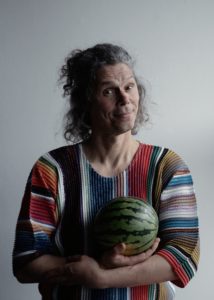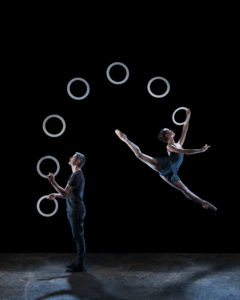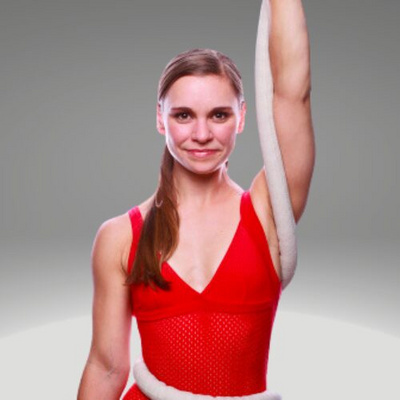Think Laterally and Trust Wild Ideas: How to Use Your Circus Skills Outside of Circus

Gandini Juggling is a world-renowned juggling company that is known for its collaborations with other art forms. I interviewed founder and director Sean Gandini in order to find out how circus artists can use their skills across disciplines to generate more performance and work opportunities. First, I asked for a run down of the company’s collaborations, which are described as “radical art/juggling fusions.” Most recently, the company was a creative force behind the Philip Glass opera Akhnaten with the Metropolitan Opera House. They have created a trilogy of works with dancers and choreographers specializing in classical ballet, bharatanatyam, and contemporary dance. The list of creative partnerships goes on: composers, fashion designers, brand names such as Hermès, and in the company’s immensely popular production of Smashed, nine jugglers collaborate with 100 apples and the “extraordinary ghost of Pina Bausch.” Similarly, the company is currently making a piece in which they invoke the universe of the late Merce Cunningham, another highly influential modern dance choreographer. Their approach is to ask, what would it be like if Cunningham were to choreograph via juggling? My aim in speaking with Gandini was to get to the root of how the company has been so successful at blending juggling with other art forms and what advice he, as a seasoned collaborator, has for other creators.

Prior to the interview, I was mulling over how artistic mediums have specific creation languages. Dancers working with dancers have an innate language they can speak that may ease a collaborative situation. When artistic genres mix, there is inevitably some disconnect in communication and comprehension. I asked Gandini if he had thoughts or advice about best practices to communicate circus/juggling effectively to people working in other mediums. Most importantly, he said, is “the ability to mold what you do to other things.” He admitted that the company has almost always had an easy time collaborating with other mediums. Partially, this is due to the fact that he felt as though the company never truly fit the traditional circus model.
We discussed the difference between layering mediums or disciplines and truly blending them. (Personally, I refer to this difference as multidisciplinary versus hybridization). Gandini said, “If you’re really collaborating, you want to stretch what you do. And it becomes difficult because the circus is so well made in its classic form, that why go messing with it?” He admitted that juggling was maybe an easier medium to stretch than other circus disciplines. He gave a beautiful description of how when a juggling pattern is repeated fifty times “it becomes a bit like visual music,” a transformation which has certainly come to life in the company’s collaborations with opera. Gandini suggested that, similarly, acrobatics is easy to pair with dance – the mediums share something fundamental. At the root of these collaborations, whether the forms have a significant amount of overlap or are completely disparate is “understanding the malleability of one’s own skill.” From there, you know how far you can stretch each medium.
I think there are two things in circles: there’s the iconography of classic circus, which is the spectacle, and then there are the skills. The skills, in my opinion, collaborate better than the spectacle.
In this stretching, things are lost and things are gained. I asked Gandini what, in his experience, one might have to let go of in a collaboration, what is gained, or what is exchanged. Harkening back to his comment about how well made classical circus is, he said, “I would say one of the main things is letting go of The Act, and that crescendo. And it’s very tricky. I think there are two things in circus: there’s the iconography of classic circus, which is the spectacle, and then there are the skills. The skills, in my opinion, collaborate better than the spectacle.” To me, this comment suggests that prior to getting into the room with a collaborator, there are questions to ask and research to be done: what is the foundational skill or technique of my circus discipline? How can that be teased away from the inherent showmanship or spectacle? What can be stretched and how far? Conversely, it might only be through the act of collaboration that these questions – and certainly more – can be explored.
Shifting topics, I asked Gandini if he know of venues, festivals, etc. that circus creators could consider seeking out in order to step outside of the typical circus circuit, or rather, dip into other circuits and performance opportunities that might welcome circus arts. In response, he told a story of a juggler that had collaborated with a female Finnish contemporary composer on a unique, gorgeous act that honored both art forms. The juggler then emailed all the orchestras in Finland with the proposition of performing the piece with them. A few returned his query with regrets, but they were interested in creating a new collaboration with him. Gandini described this as lateral thinking: where are there audiences that would be interested in seeing what you have to offer? He admits, “We didn’t go out on purpose to get into the opera houses of the world. But now, in retrospect, it seems so like there’s a lot of people who like seeing things.They haven’t seen a lot of circus, so when they see juggling, it’s a revelation. Many people say, ‘Oh my gosh, I’ve never seen juggling like that!'” He continued to say how the company has “always had our eggs in many baskets. We’ve always had six or seven things on the go. I remember we did a piece in a contemporary art museum in France, and then I thought, ‘Gosh, are we contemporary art?’ And then I thought, ‘Yeah, we are, because we are in the museum.'” Expanding your circus skills laterally could come in the form of stretching your art to blend it with other mediums, performing in venues that are typically reserved for other arts or events, or even just thinking of your work as a different medium and seeing where it can fit and fly.

Things aren’t always rosy, so I asked Gandini what some pitfalls or cautionary tales he had to pass on from the company’s many collaborations. He admitted to being lucky and not encountering too many disasters. He chalked much of this up to his own optimism and admitted that there were situations where someone with less patience may have walked away. He did insist that first impressions tend to be correct, and much can be assessed early on in the collaboration process. We spoke about the realities that, like any artistic endeavor, collaborations need funding. It was not the aim of our conversation to discuss resources for funding such collaborations, but it is a realistic necessity that shouldn’t go unaddressed.
As the conversation came to a close, Gandini described, “There’s so much to be done with circus. The other day I watched these two teeterboard kids and they were doing teeterboard and pingpong spitting. And I thought, ‘that’s great!’ That’s what circus is, isn’t it? To take two completely disparate things and put them together. Then we were trying to think of the most absurd things to put with teeterboard: ventriloquism and teeterboard, an hour of fun and frolics! Personally, I just gamble on craziness because doing circus is a crazy idea to start with.”
I left the conversation feeling enlivened, partially from Gandini’s chronic enthusiasm and good cheer (which even the Zoom screen could not dilute), but mostly because our conversation tapped into the electric feeling of freedom you get when you give yourself permission to step outside of norms and boundaries. Gandini’s words are an excellent reminder that circus itself already stretches possibility, so to continue to stretch your personal potential and that of your discipline through reframing or collaborations might be the most circus thing you can do.
Featured Image: Kate Byrne and Owen Reynolds. Photographer: Arnaud Stephenson. From: Gandini Juggling's 4x4 Ephemeral Architectures, 2015.
Related: Inside Ephemeral Architectures with Gandini Juggling, Gandini’s Smashed Delivers a Disquieting Minefield of Apples, Tea Sets, and Gender Dynamics, Who Brought the Jugglers to the Metropolitan Opera?
Editor's Note: At StageLync, an international platform for the performing arts, we celebrate the diversity of our writers' backgrounds. We recognize and support their choice to use either American or British English in their articles, respecting their individual preferences and origins. This policy allows us to embrace a wide range of linguistic expressions, enriching our content and reflecting the global nature of our community.
🎧 Join us on the StageLync Podcast for inspiring stories from the world of performing arts! Tune in to hear from the creative minds who bring magic to life, both onstage and behind the scenes. 🎙️ 👉 Listen now!
